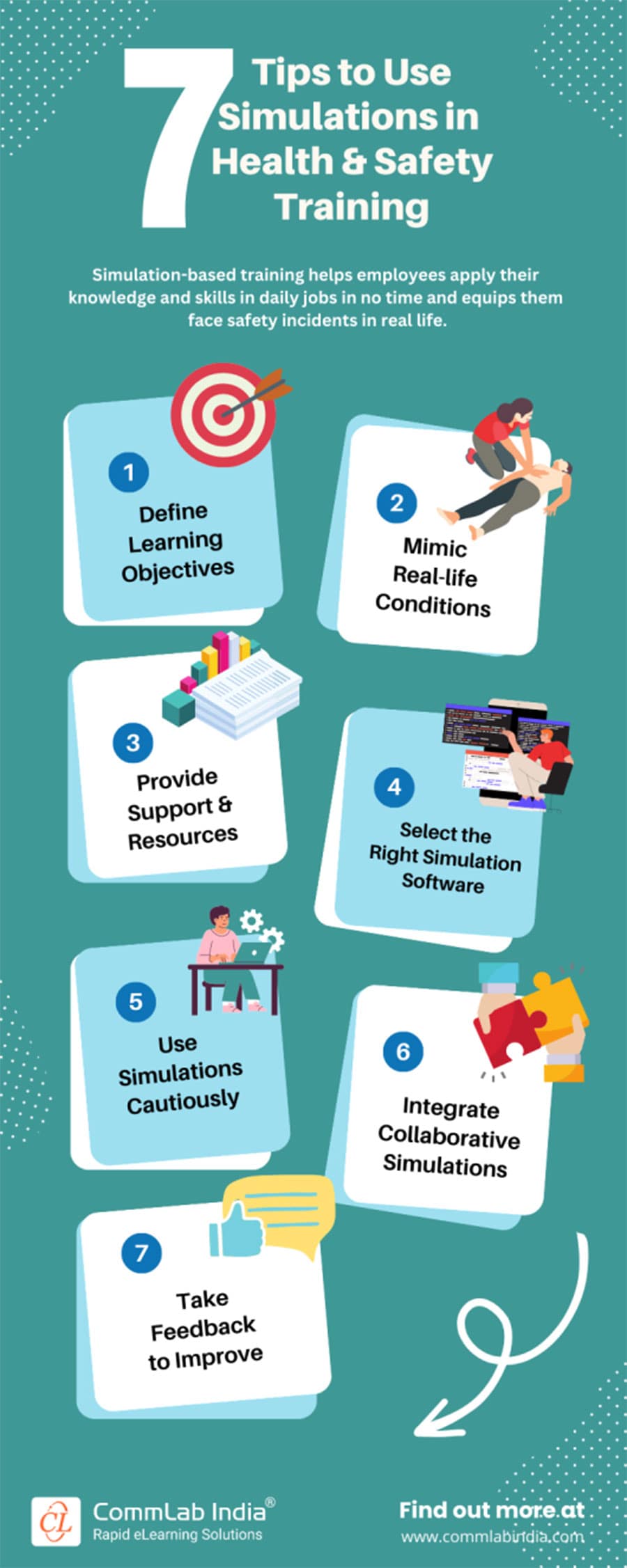Tips to Boost Health & Safety Training with Simulations [Infographic]
![Tips to Boost Health & Safety Training with Simulations [Infographic] Tips to Boost Health & Safety Training with Simulations [Infographic]](https://blog.commlabindia.com/hubfs/blogs/simulations-in-health-and-safety-training-tips.jpg)
Employees may perceive accident avoidance, adherence to safety guidelines, and emergency response as straightforward tasks. However, real-world safety challenges often reveal their complexity. Imagine if your workforce could practically apply health and safety concepts in a risk-free, simulated environment mirroring the workplace. This approach facilitates adept handling of accidents and critical situations. The integration of eLearning simulations in online health and safety training serves as a practical solution to achieve this objective.
Simulation-based online training efficiently translates knowledge and skills into daily job applications, preparing employees to tackle safety incidents in real-life scenarios.
What is Simulation-Based Online Training?
Simulation-based online training is a form of eLearning that utilizes interactive scenarios to replicate real-world situations. It allows learners to apply theoretical knowledge in a risk-free virtual environment, enhancing practical skills and decision-making abilities.
Now, let's delve into essential tips for implementing eLearning simulations to enhance the effectiveness of your health and safety training.
7 Tips for Elevating Health & Safety Training with eLearning Simulations
1. Define Learning Objectives
Set defined learning goals to determine the effectiveness of your simulation-based safety training. Defining precise and measurable learning objectives helps you get the desired outcome from the online training. You have to decide how safety simulations will support skills and fill gaps to achieve tangible results. Link online training scenarios to real-world applications. For instance, after completing this safety simulation, the worker has to come out of a multi-storeyed building through the fire exit within the specified time.
2. Mimic Real-Work Conditions
While implementing simulations, a best practice is to keep the scenario as close to regular situations as possible, and take the time factor into consideration. For example, when you develop a safety simulation to prevent a fire outbreak, keep the average time required to react in that situation close to real-life circumstances. Serious games based on simulations will bring out the emotions and build vital skills to react promptly in unexpected real-life situations.
3. Provide the Needed Support & Resources
Employees have to know what they need to achieve and the resources that are available to them. Provide clear instructions on how to go through the health and safety simulation and show them how to use the navigation controls. Give them the needed resources such as an overview of the skills and procedures covered in safety simulations and give them a chance to conduct trial runs of the online safety training. This helps your employees explore the health and safety simulations directly. It’s also useful to find out the potential barriers and suggest additional online safety training resources.
4. Select the Right Simulation Software
There are numerous authoring software tools out there in the market. However, only a handful of tools suit your custom safety training requirements. High-end authoring tools come equipped with rich multimedia, themes, and character cut-outs. If you want to adjust with basic software, you need to source your media through royalty free pictures and audio sites. You should also consider the nature of the health and safety simulation you want to develop. For instance, depending on the media you want to use and the complexity of the tasks.
→ Access Now: Instructional Design 101 [eBook]
5. Use Simulations Cautiously
Don’t fill your online safety course with simulations from start to end. Use them carefully to make your online training more memorable and powerful. Your employees should have two essential elements before they are introduced to the online training activity:
- Pre-existing knowledge
- Awareness of relevancy
They should know how to apply the knowledge and skills to their daily work, and link safety simulations to the real world. Economical use of simulations reduces the size of your safety training. Then it’s simple to digest without the cognitive overload.
6. Combine Simulations with Collaborative Learning
Simulations are often inquiry-based. Employees learn by gathering real data and examining various aspects of the situation. You can combine these benefits by offering collaborative learning opportunities. For instance, create group-based simulations that are paired with online discussions. Workers can see how their colleagues reacted in the same condition, which facilitates them to reflect on personal strengths and weaknesses.
7. Take Feedback to Improve Safety Simulations
Ask your employees relevant questions after taking the simulation-based safety training. This helps analyze their decisions and behaviors, such as where they struggled and ways to improve the safety simulation. You can also analyze reports generated by your Learning Management System (LMS) to know the learning patterns. This shows where the majority of learners are facing difficulties or the areas to improve in the given safety training program.
Explore more about our LMS:
Summing Up
Simulation as an instructional design strategy is particularly effective in contexts where hands-on experience is crucial, such as in health and safety training, technical skills development, and complex decision-making scenarios.
And now that you know the tips, make the best use of them to build effective simulation-based safety training that facilitates practical learning experience for your employees, so that they can respond the right way to real-life situations.
To explore more about such engaging and interactive instructional design strategies, click on the link below:
Editor’s note: This post was originally published in February 2018 and has been updated for comprehensiveness.






![How to Design Effective Safety Training Programs with Rapid eLearning [Infographic]](https://blog.commlabindia.com/hubfs/blogs/rapid-elearning-safety-training-infographic.jpg)
